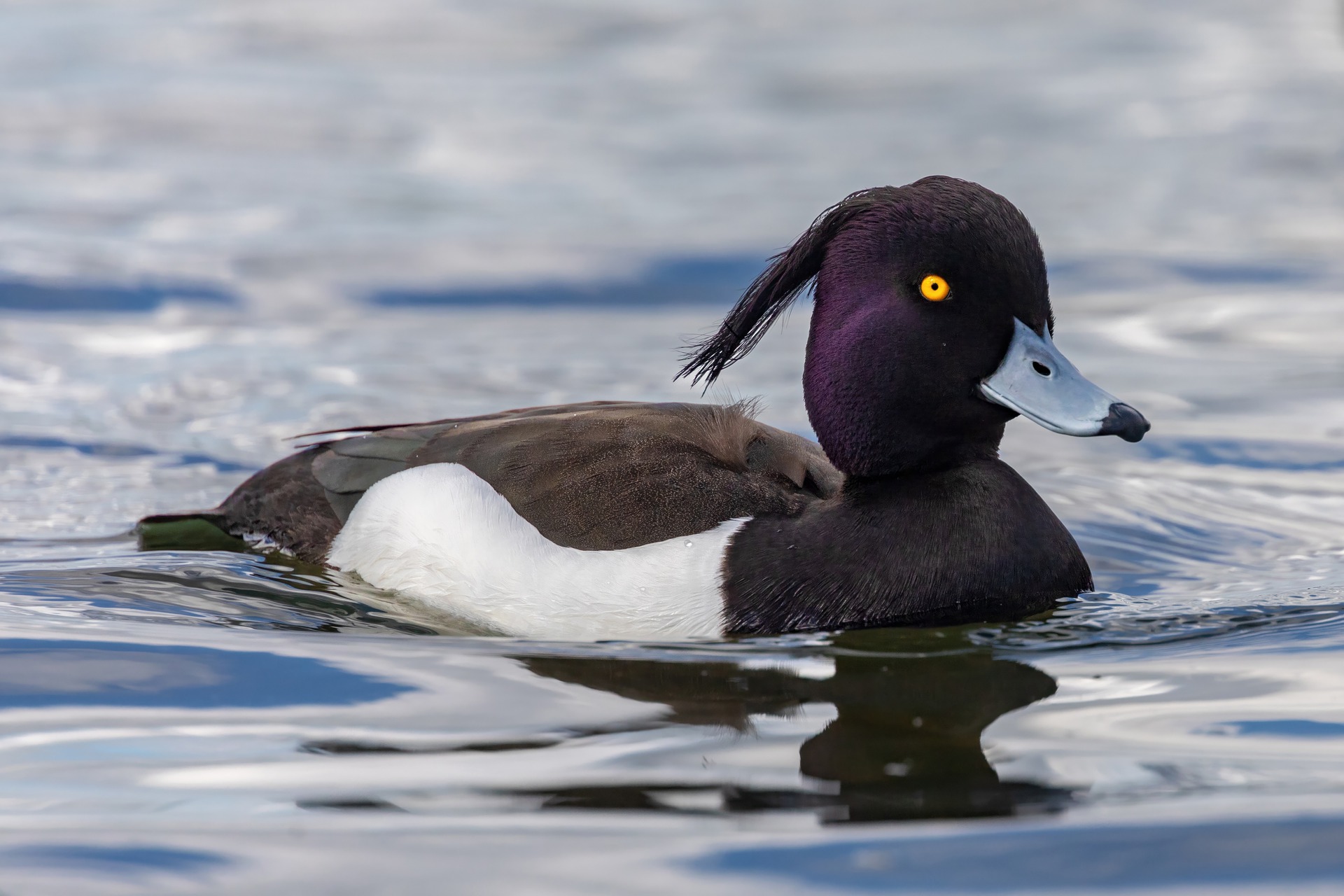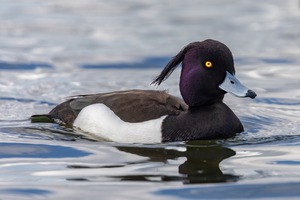 LINKED PAPER
LINKED PAPER
Long‐term increase in female body condition–and its effect on reproduction in two European red‐listed species, Common Pochard Aythya ferina and Tufted Duck Aythya fuligula. Gajdošová, D., Musil, P., Zouhar, J., Musilová, Z., Neužilová, Š., & Pavón‐Jordán, D. 2023 Ibis. doi: 10.1111/ibi.13208 VIEW
European populations of Common Pochard (Aythya ferina) and Tufted Duck (Aythya fuligula), sympatric diving duck species, have declined rapidly over the past few decades (Fox et al. 2016). Numbers of Common Pochard have declined by over 30 % in the past three generations and this species has subsequently been classified as Vulnerable on the IUCN Red List of Threatened Species (IUCN 2022). These species of diving ducks are threatened by habitat loss and intensive fishpond management (Musil 2006). Therefore, studies that improve our understanding of such threats and potentially reverse population declines are extremely necessary.
Even though female survival of Common Pochard in western Europe has not shown significant declines (Folliot et al. 2020), the species experiences a skewed adult sex ratio (Brides et al., 2017) which could lead to changes in the proportion of breeding females and reduced productivity of breeding populations.
Body condition is an essential driver of adult survival and the consequent fitness of individual birds. Long-term changes in female body condition, especially during the egg-laying and clutch incubation periods, can result in changes to wider population dynamics.
We measured the body conditions of breeding females in the late stage of incubation in the Třeboň Biosphere Reserve located in Southern Bohemia, Czechia, between 2004 and 2020. Since the 16th century, intensively managed fishponds have been built for predominantly Carp (Cyprinus carpio) production throughout this area. Female ducks nest in the shorelines of these fishponds or under the protection of Black-headed Gull (Chroicocephalus ridibundus) colonies on breeding islands.
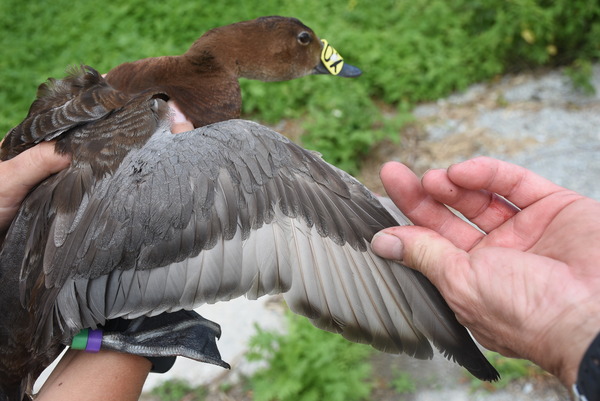
Figure 1 Female Common Pochard (Aythya ferina) marked with coded nasal saddle and coloured rings © Petr Musil.
In total, of 139 females Common Pochards and 251 Tufted Ducks were trapped during the late stage of incubation on nests using drop-door traps (Weller 1957). After trapping, tarsi measurements (cm) and weight (g) of each female were obtained. To assess female body condition, we developed
a tarsus-based body condition index (BCI). This index is based on the residuals from the regression of (log transformed) body mass and (log transformed) tarsus length, but unique in insertion of the incubation stage (number of days before hatching) as an additional predictor of body mass in the regression. This allowed us to express BCI of late incubating breeding females more accurately while accounting for the steady decline in their body mass during egg-laying and clutch incubation.
Each female was banded and marked with an individually coded nasal saddle and a unique combination of color rings on both legs. This individual marking technique is used widely among ducks for long-term individual identification allowing for the study of individual nesting and breeding success or bird’s movement within and between breeding and wintering sites.
Long-term improvement in body condition of a declining species
Over a 17-year period, we found a long-term increase in body condition of late incubating females in both species. Waterfowl in general are expected to be a capital breeder relying on stored body nutrition from wintering sites for the upcoming breeding season. However, in a temperate zone with mild winters, they may rely on a combination of stored and locally acquired nutrition for clutch formation and incubation (Guillemain et al. 2008). We therefore additionally tested the effect of temperature on wintering sites as the main driver affecting birds prior to breeding season, and the effect of water transparency (a proxy for food availability) at their arrival to the breeding sites, but none of which were significant in our models. The result of long-term improvement in BCI over the past two decades of both studied species provided the evidence that females that incubate clutches long enough to be trapped in the late stage of incubation do not suffer from reduced body condition, which also plausibly affects their nesting success.
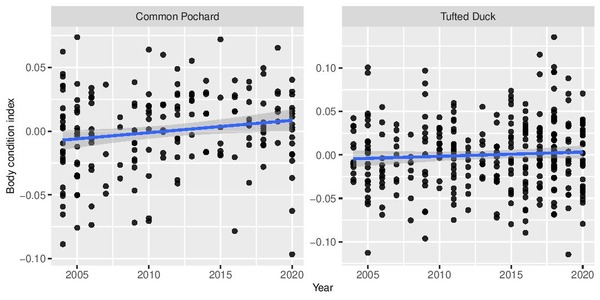
Figure 2 Effect of year on body condition index (the residuals from the regression of the log of mass (g) on (i) the log of tarsus length (cm) and (ii) the incubation stage; 95% CI) in Common Pochard and Tufted Duck (BCI values of individual female expressed in black circle).
Body condition has a positive effect on egg mass and hatchability
In addition, we studied the effect of body condition on breeding parameters, such as laying date, egg mass, clutch size and hatchability of each incubating female. The broadly studied trade-off between egg mass and clutch size (Rohwer 1988) describes that birds with large body size have relatively smaller clutches but bigger eggs than smaller-bodied birds. We found a positive effect of BCI on mean egg mass in both species, but a long-term increase in total clutch size (including parasitic eggs) was found as the only significant variable for the Tufted Duck. However, this result is more likely associated with high nest parasitism (Neužilová and Musil 2010) occurring especially in the later parts of the breeding season.
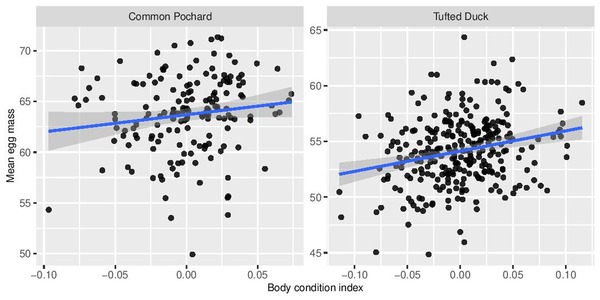
Figure 3 Effect of body condition index (the residuals from the regression of the log of mass (g) on (i) the log of tarsus length (cm) and (ii) the incubation stage; 95% CI) on mean egg mass in Common Pochard and Tufted Duck (BCI values of individual female expressed in black circle).
BCI also had a positive effect on hatchability in each studied species. However, the overall hatchability of the breeding population decreased over the 17-year study period which should be accounted for in future population studies.

Figure 4 Ducklings of Common Pochard (Aythya ferina) (at the back) and Tufted Duck (Aythya fuligula) (at the front) in a parasitized nest of Common Pochard © Barbora Kováříková.
Conclusion
Over the course of the study, we found that females breeding in Czechia do not suffer from reduced body condition, and body condition is positively related to their breeding output (females in better body condition produce larger eggs and have a higher hatchability). Even though we did not reveal any variable associated with habitat conditions that could explain annual variation in female body condition, the decreasing population size of Common Pochard, as well as Tufted Duck, could be related to changes in population structure (proportion of breeding females) and/or in duckling survival closely connected to limited food availability in the later part of their breeding seasons. In fact, the limitation of food availability aggravated by intensive fishpond management is alarming for duckling survival.
To find the key drivers underlaying the population declines of these threatened species of diving ducks, it is important to note here, that future studies should be more focused on duckling survival, and monitoring of offspring recruitment into the breeding population.
References
Brides, K., Wood, K., Hearn, R., & Fijen, T. P. 2017. Changes in the sex ratio of the Common Pochard Aythya ferina in Europe and North Africa. Wildfowl 67:100-112. VIEW
Fox, A. D., Caizergues, A., Banik, M. V., Devos, K., Dvorak, M., Ellermaa, M., Folliot, B., Green, A. J., Grüneberg, C., Guillemain, M., Håland, A., Hornman, M., Keller, V., Koshelev, A. I., Kostiushyn, V. A., Kozulin, A., Ławicki, Ł., Luiguijõe, L., Müller, C., Musil, P., Musilová, Z., Nilsson, L., Mischenko, A., Pöysä, H., Šćiban, M., Sjeničić, J., Stīpniece, A., Švažas, S. & Wahl, J. 2016. Recent changes in the abundance of Common Pochard Aythya ferina breeding in Europe. Wildfowl 66:22-40. VIEW
Guillemain, M., Elmberg, J., Arzel, C., Johnson, A. R., & Simon, G. 2008. The income–capital breeding dichotomy revisited: late winter body condition is related to breeding success in an income breeder. Ibis 150:172-176. VIEW
IUCN. 2022. The IUCN Red List of Threatened Species. Version 2022-2. https://www.iucnredlist.org. Accessed on [16 04 2022]
Musil, P. 2006. A review of the effects of intensive fish production on waterbird breeding populations. Waterbirds around the world. The Stationery Office, Edinburgh, UK, 520-521
Neužilová, Š., & Musil, P. 2010. Inter-specific egg recognition among two diving ducks species, Common Pochard Aythya ferina and Tufted Duck Aythya fuligula. Acta Ornithologica 45:59-65. VIEW
Rohwer, F. C. 1988. Inter and Intraspecific Relationships between egg size and clutch size in waterfowl. Auk 105:161-176. VIEW
Weller M.W. 1957. An automatic nest-trap for waterfowl. The Journal of Wildlife Management 21:456-458. VIEW
Image credit
Top right: JonPauling CC0 Pixabay.
If you want to write about your research in #theBOUblog, then please see here.


